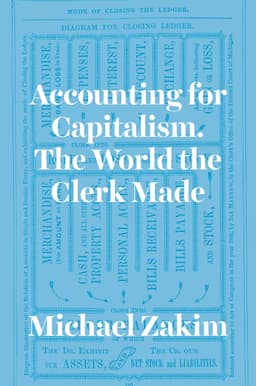
Book Review
Accounting for Capitalism. The World the Clerk Made, 2018
By Michael Zakim
Buy the book: https://press.uchicago.edu/ucp/books/book/chicago/A/bo5925490.html
Modern capitalism has been constructed by a range of players at different points in time. Accounts of its rise have often focused on the role of business leaders while the influence of less eminent contributors has often been ignored. Recent scholarship has been written to help refocus the attention to the lesser known creators of capitalism and Michael Zakim’s Accounting for Capitalism: The World the Clerk Madeis a contribution to the emerging effort. This book is an examination of development of the clerk occupation in the antebellum United States, the rise of statistical control in business, and some of the consequences of both developments and related issues for American business. This is an ambitious book that is often persuasive that also opens avenues of unresolved inquiry.
Zakim provides a detailed narrative on how the clerk occupation developed, controlled, and integrated into organizational processes. The world of the antebellum clerk was male, largely lacked automation, was not particularly healthy, and revolved around routine and number. In many ways, it resembled a monastic existence with little expected time for leisure or self- indulgence. Zakim appropriately notes that clerks in 1830s to 1850s America lived in a society that enthusiastically, if ostensibly, embraced the virtues of self-reliance, temperance, and industry. He duly notes the influence of writers like Benjamin Franklin, Horatio Alger, and Horace Greely. Works like Alger’s Ragged Dick were considered guides on how young men should advance themselves personally and professionally.
The routinization of work was achieved through the use of methods like teaching a uniform method of cursive writing, the introduction of bookkeeping routines, and careful organization of office work. Zakim mentions Edgar Allan Poe, who worked as a clerk before achieving literary fame, and how Poe coined the term “deskism” to describe the clerk’s working environment (3). The United States experienced considerable economic expansion in the 1830s, but clerks were not well compensated as they were at lower levels of their organizations. Zakim’s recounting of concerns about diet, digestion, and physical activity suggests that clerks did not always enjoy good health.
Zakim’s analysis ends with the 1850s, and then leaps forward in his final chapter to the 1940s and 1950s in an effort to link the lives of nineteenth-century clerks to those of the managers and other office dwellers described by William H. Whyte and C. Wright Mills. This effort is somewhat of a stretch and leads to the principal difficulties with Zakim’s analysis; periodization and what could have been included in the book. The reason that the period from the 1830s to the 1850s was chosen could have been more fully explained, especially since this is widely acknowledged by historians as the main ante-bellum period. A second issue relates to the communities in which clerks lived. Zakim refers to New York City but readers are not told if the clerk role was truly uniform across the ante-bellum United States or if it varied depending on the state in question.
Some gender-based analysis is used in this book, as the clerk role is shown to have been overwhelmingly male. However, historians have already shown that the clerk role was primarily male prior to the introduction of office technology. The introduction of equipment like the typewriter gradually turned the clerk role into a female occupation that carried much less social status. Zakim briefly describes the social lives of clerks, but there is little evidence that the clerk role guaranteed upward social mobility of the kind promised by Alger and others. This book also does not say if clerks married and had families or if they found themselves relegated to confirmed bachelor status due to their comparatively low wages. Clerks were encouraged to think about material progress but it is not clear if they enjoyed much of it.
The book is not structured around a clear theoretical framework, which is not necessarily a criticism, although Marx is referenced at several points in the narrative. Zakim uses Marx to help explain the nature of office work but does not mention the vast literature on job rationalization including the work of Harry Braverman. Some historians will likely look for more discussion on how the clerk role compared to other rationalized jobs. On the other hand, it has much appeal for business and management historians. Reading the extant literature on the evolution of complex organizational structures often leads to the conclusion that business processes became more routinized after the Civil War. Zakim ably shows that numbers were becoming key to management in earlier decades. Whereas Alfred Chandler explained the creation of complex business structures, Zakim provides some insights into the earlier development of the processes that made large business operations possible. For instance the term “paperwork” was commonly used throughout the twentieth century and its antebellum origins are shown in this book. It is consequently a useful addition to the growing literature on the development of business, management, and labour in nineteenth-century America. Its strengths generally outweigh any of its weaknesses and readers will think differently about cursive writing, spreadsheets, and the other many apparatuses of administrative life the next time that they see them.
Jason Russell
SUNY – Empire State College